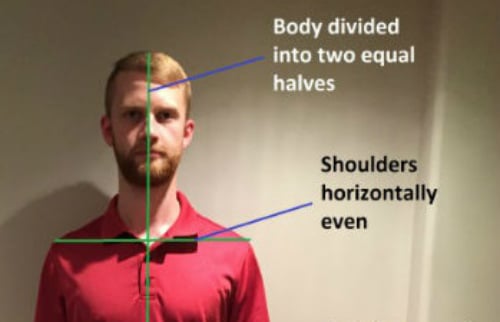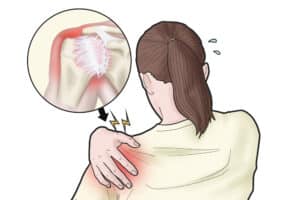What is Good Posture?
Posture can be defined as the position or alignment of body parts. Good posture is when our body is positioned in a way that places the least amount of strain on our ligaments, bones, joints, and muscles. It’s important to maintain a neutral spine. It should be relatively easy to maintain such a position for extended periods of time.
What is Meant by Center of Mass and Base of Support, and How Are They Related to Posture?
Describing what good posture looks like is more complicated than you might think. To start, it is important to understand the concept of center of mass. Center of mass can be thought of as the single point where all the mass of an object is evenly distributed around. For example, in a uniformly-shaped object, such as a perfect cube or sphere, the center of mass would be in the exact center. In a human with a healthy weight, average dimensions and who is in a standing position with excellent posture, the center of mass would be located inside the body, behind the navel (belly button) and near the bodies of the lower lumbar vertebrae.
A second important concept is base of support, or the area beneath an object that is bounded by the points of contact that the object has with the supporting surface. Again, this is explained better through an example; if we think about our ideal human in their perfect standing posture, the base of support would look something like a trapezoid. Furthermore, when standing with good posture our center of mass should be situated over the base of support that is created by our feet. Ideally, it would be directly between our feet so that there is even distribution on both sides of our body. The following picture will help demonstrate this:
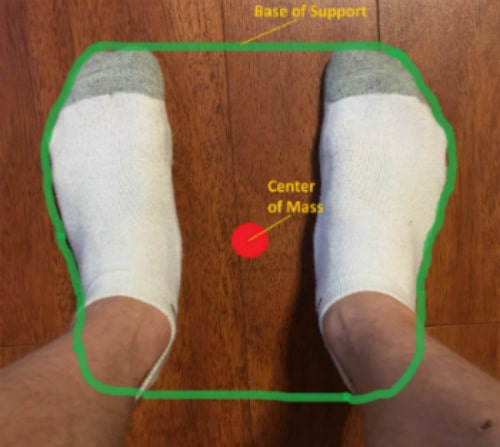
Notice the trapezoid-like “base of support” (marked in green) that is created by the contact of our feet with the supporting surface. The red dot labeled “center of mass” is where the center of mass of our body should be located in our base of support (when we are in good standing posture) if we were to draw a straight line from it down to the ground.
What Does Good Posture Look Like?
Now that we understand how posture works, we can establish what this looks like in the human body. The following pictures will show some of the many reference points you can use to help you find a good posture:
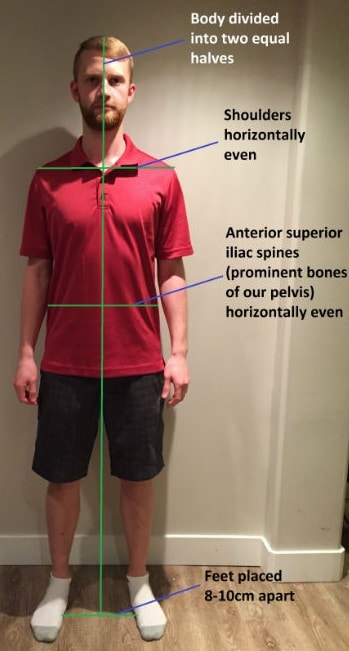
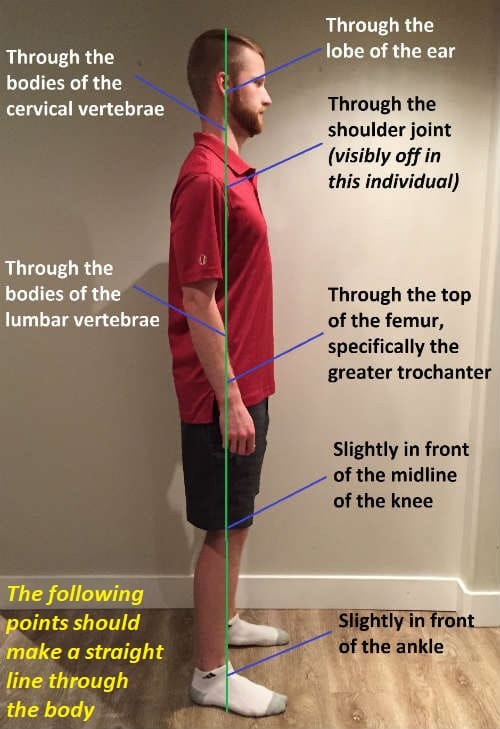
What Are Postural “Cues”?
Postural cues are simple ways of reminding ourselves to adjust our posture into a better position. Of course, there are an infinite number of cues you could develop for yourself, so long as they adhere to the information about good posture provided thus far. The following are a few memorable ones that I have picked up over time:
- Drool Test (Head/Neck) – If you were to let yourself drool to the point where the saliva ran from your mouth and down your chin, then when it drips it should land at the top of your sternum. If the drool lands in your sternal notch (concavity at the base of the neck behind the sternum), your head is too far back. If the drool lands past the top of the sternum, then your head is too far forward. You could also place a ruler against your chin and down to the top of the sternum. If you reach a point where you as feel as though you are restricting your airway, even if it is before the ideal position of the drool test, stop the movement before that point.
- Shoulders Back/Chest Puff (Shoulders/Chest) – It is becoming more common to find individuals with shoulders that are rounded forward, and a chest that is rounded inward. If your shoulders are too far forward (refer to pictures of good posture) then you simply need to remind yourself to pull them back slightly. At the same time, puff your chest out minimally. It is important to realize that these are small, subtle movements; if you pull your shoulders too far back you are asking for backward rounded shoulders, and if you puff your chest out too far you are going to hyperextend your lumbar spine.
- Spread the Ground (Hips) – In an ideal standing posture, our feet should be pointed just slightly out from perfectly straight forward. Feet that are pointed inward or markedly outward are less optimal. This postural cue will help with feet that are pointed too far out (more common than inward-facing). Essentially, you want to push outward from your heels, as though you are trying to spread the ground apart that is directly beneath you. You should feel work from the muscles around your hips.
- Soft Knees (Knees) – From your neutral standing posture, if you were to suddenly extend your legs at the knees, your knees should move backward slightly before “locking”. If no movement occurs at the knees when you perform this action, it means that your knees are already locked in your neutral position. For this postural cue, remind yourself to unlock your knees ever so slightly when standing. It will likely feel very odd for the first few days, but your body will eventually adjust.
- Arches Up (Feet) – If the arches on the inside of your feet are absent (flat arches), it can strain and alter the posture of other parts of the body, such as the knees. For this postural cue, activate the muscles in your lower legs that pull the feet upward at the arch, but maintain contact with the floor at the balls of your feet and your heels. Avoid curling the toes while performing this.
Does Posture Only Refer to When We Are Standing?
Although it has been the focus of this post, it should be noted that posture doesn’t exclusively refer to when we are in a neutral standing position. In reality, it includes any position that we place our body in, whether it be static (such as sitting or standing), or dynamic (such as running, jumping, squatting), though dynamic positions are often referred to as our “form.”
The concepts of center of mass and base of support still hold true in most of these situations. For example, you may have heard that you should bend at the knees while lifting an object off the floor, and to lift it close to your body. This is because if you bend entirely at the lower back and lift the object far from your body, your center of mass moves forward and well outside of your base of support. To maintain your balance (prevent you from falling forward), the muscles of your lower back would have to work astronomically harder, which can result in an injury.
Can I Achieve Perfect Posture?
In reality, there is no such thing as a perfect posture. We all have individual differences in our anatomy and biomechanics, whether it be the result of genetics, individual factors (eg. poor postural habits, age), or environmental factors (eg. poorly designed work environment, disease), that bar us from developing and maintaining a perfect posture.
However, although we may never be able to perfect the posture of our body, we are all capable of making improvements to our posture over time in one way or another. Just remember that these changes should be done very gradually. In other words, don’t hold a postural cue through an entire day when you are first performing it, otherwise you are going to fatigue your body and create new aches and pains. Short holds of 15-30 seconds at a time for a few times each day is a good start, and then you can slowly increase duration and frequency every few days until it becomes habitual.
References
Justin, B. (2016). Postural and Palpation Assessment.

